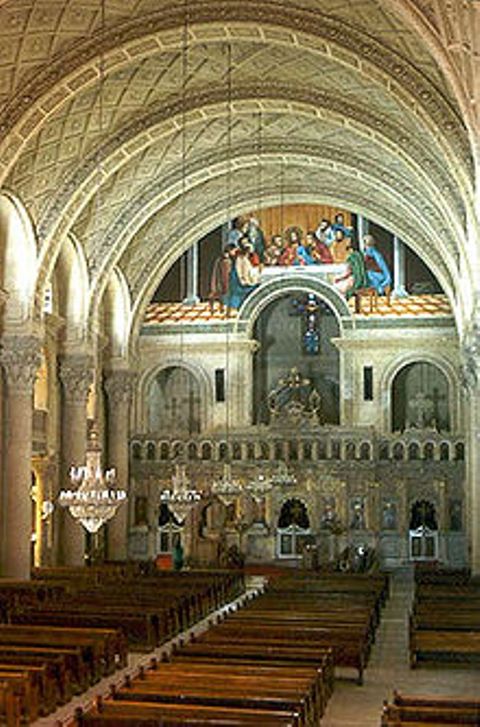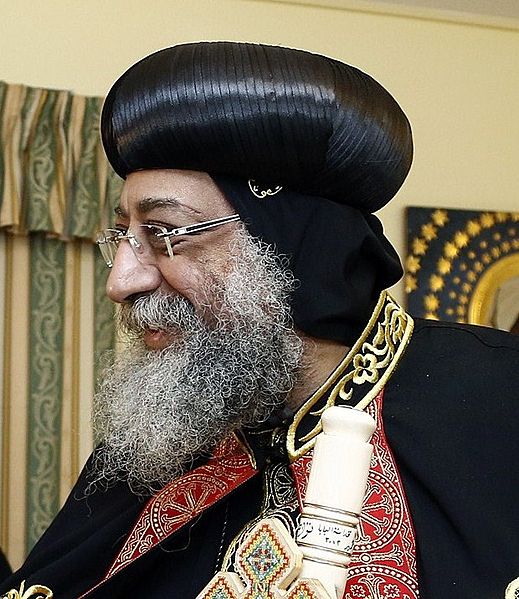The headline was startling: “Pope Tawadros and Saudi ambassador agree to open Saudi Arabia’s first church.”
The report would be historic since by law, no church buildings are allowed in Saudi Arabia, where Islam is the only religion permitted. Tawadros is the leader of Egypt’s 1.5 million Coptic Christians.
“A reliable source has told Mideast Christian News that Pope Tawadros II, Pope of Alexandria and Patriarch of Saint Mark’s Episcopate, has reached an agreement with the Saudi ambassador in Cairo, Ahmed Kattan, to establish the first church ever built inside Saudi Arabia,” wrote Irin Moussa of Mideast Christian News.
The Coptic pope meets with the Saudi ambassador (MCN Photo)
“The source said that Pope Tawadros was extremely happy upon his return to the Cathedral in Al-Abbasiya, where he met with a German parliamentary delegation after the end of his first visit to the Embassy of Saudi Arabia,” wrote Moussa.
“MCN was told that the Pope thanked the King of Saudi Arabia and the current government for their approval to build the first church, which will be Coptic, and for the warm welcome from the Saudi ambassador in Cairo. The source added that at the meeting, the two leaders also discussed consolidating relations between the Church and Saudi Arabia, especially after the king of Saudi Arabia pledged to send aid to Egypt after the revolution of June 30. His Holiness also expressed his condolences for the victims of the recent fire in a Medina hotel.
“There are many Egyptian Copts in Saudi Arabia, and there are also more than a million Christians from Southeast Asia, particularly from the Philippines.”
Indeed, the Catholic community in Saudi Arabia is overseen by the Apostolic Vicariate of Northern Arabia and has its own bishop, Camillo Ballin. However, he is not allowed to set foot in Saudi Arabia – instead has his offices at the Holy Family Cathedral in Kuwait.
Kuwait’s Holy Family Cathedral (Wikimedia photo)
The existence of that church has been an irritation to the Saudis. In 2012, the Grand Mufti of Saudi Arabia declared that all churches in the Arabian Peninsula must be destroyed.
“Grand Mufti Sheikh Abdul Aziz bin Abdullah made the controversial statement in a response to a question from a Kuwaiti delegation,” reported the Russian news agency Novosti. “The Grand Mufti, who is the highest official of religious law in Saudi Arabia, as well as the head of the Supreme Council of Islamic Scholars, cited the Prophet Mohammed, who said the Arabian Peninsula is to exist under only one religion.
“The Sheikh went on to conclude that it was therefore necessary for Kuwait, being a part of the Arabian Peninsula, to destroy all churches on its territory.”
Ironically, the oldest church building in the world, the 4th century Jubail Church is located in Jubail, northern Saudi Arabia. “It was
discovered in 1986,” reports the website Above Top Secret. “The government hides it from locals and bans foreigners from visiting it, even archaeologists. It is an ancient Assyrian church possibly of the Nabatean culture.
The Jubail ruins (Photo by Robert McWhorter/Wikimedia)
“In 1986, people on a desert picnic discovered the ruins of a church near the city of Jubail, Saudi Arabia, while digging one of their trucks out of the sand. The church is believed to have been built prior to A.D. 400, making it older than most churches in Europe. It was likely associated with one of five bishoprics existing on the shores of the Arabian Sea during the term of Nestorius, Patriarch of Constantinople and founder of the heresy that bears his name.
“Anyone familiar with contemporary Latin and Eastern Rite Catholic church buildings will recognize the basic design. The foundation marks for roof support columns in the main room easily identify it as the nave of a church. Probably, the roof was a thatch of palm branches supported by risers and crossbeams about a foot above the walls for sunlight and ventilation. The congregation would have entered through the main doorway at the west side of the nave and assembled, women standing to the right and men to the left, facing east toward the sanctuary (the middle of the three smaller chambers”) where the altar would have been.
“At the doorways to the sacristy, sanctuary, chapel, and the main entrance, stone crosses were attached to the wall. These four crosses, in place during the early excavation, disappeared in late 1986 or early 1987. Over the years since the discovery, the desert has erased even the marks left when the crosses were removed.”
The Saudi government has fenced off the site with barbed wire, saying it is protecting the archeological site.
And what about the reports that the Saudis are going to allow a church to be built?
“The Coptic Orthodox Church has denied reports of a meeting between Pope Tawadros II and Saudi Arabian officials to open the first church in the country,” reports the website Christian Today. “The Coptic Orthodox Church has issued a statement refuting reports that the Coptic Pope has met Saudi Arabian officials over the creation of the first church in the country.
“The MidEast Christian News agency reported that a meeting had taken place between Pope Tawadros II and Saudi Ambassador Ahmed Kattan about the possibility of setting up a church.
“However the Coptic Orthodox Church in the UK has released a statement saying that the story is a case of “misreporting”.
It confirmed that a meeting did take place between the two leaders but that it related to a pastoral visit to the country by a bishop in the Church.
Pope Tawadros II of Alexandria (Wikimedia photo)
"This was however a strictly cordial visit by His Holiness Pope Tawadros to the Saudi ambassador to express his thanks for the assistance provided in facilitating the pastoral visit of a Coptic Orthodox bishop to Coptic Christians in Saudi Arabia," the statement said.
Meanwhile, although no churches are allowed in the country, Saudi Arabia does allows Christians to enter the country as foreign workers for temporary work, but does not allow them to practice their faith openly. During the Kuwaiti war, American troops were cautioned not to carry Bibles in public. Chaplains were required to remove the crosses from their lapels.
“Because of such prohibitions, Christians generally only worship in secret within private homes. The Saudi Arabian government’s Committee for the Propagation of Virtue and the Prevention of Vice – the religious police – energetically prohibit any displays of crosses or other non-Islamic religious symbols.
Conversion of a Muslim to another religion is punishable by death.
Despite this, the migrant community of believers is growing and
converts are responding to Christian TV programs, reports Open Doors. Another phenomenon is widely reported -- of Muslims converting to Christianity after experiencing visions in which they said Jesus appeared to them.
"Christians risk further persecution and oppression in the future due to the rising number of converts and their boldness in sharing their faith," reports Open Doors. "In July 2012 the media reported the story of a young Saudi woman who converted to Christianity after her Lebanese employer shared the gospel with her. With his and a Saudi colleague's aid, she fled abroad. The lady's family filed charges against the employer. According to the Saudi Gazette, he was detained and taken to court. A month later, it was reported that the Saudi authorities had started to block several Christian websites."
And for the time being, apparently there will be no churches built, Coptic or otherwise.





